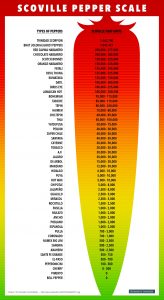Hello, Interest,
So we just read a book called Little Brother . It focussed on a boy who got blamed for a terrorist attack, arrested and treated unfairly, and decided to rebel against the government that captured him. Actually, he was a bit of an idiot. The book, however, was enjoyable.
The book related back to our driving question for this unit, “how has technology acted as a disruption with its creation throughout history?”, and to our ongoing theme of identity.
And it’s about a part of the identity of one of the characters from Little Brother that I’m writing this post now. The book featured a character called Ange who loved hot sauce, enough for it to be a part of who she was. She even spent a significant amount of time building up an immunity to hot sauces which, she explained, ranked high on the Scoville Heat Scale.
You might not be sure what the Scoville Heat Scale is. Luckily, I have an explanation for you:
The Scoville Heat Scale, named after Wilbur L. Scoville, is a basic representation of the heat/hotness/spiciness of different hot peppers, hot sauces, or dishes containing large amounts of said peppers or hot sauce. The literal thing that it’s measuring is a pepper’s concentration of capsaicin, which is the component that makes human beings feel heat.
At the bottom of the scale (at literally zero) would be something like a sweet pepper, which does not contain capsaicin, and therefore isn’t hot. Closer to the top would be certain types of chili peppers that can reach over 300, 000 Scoville units. What this means, essentially, is that in order to make the amount of capsaicin in a pepper of this kind undectable to a human, extract from that pepper would have to be diluted in sugar water by a ratio of 1: 300, 000 units of water. Diluting pepper extract in sugar water and tasting it in order to determine how hot it was is a procedure that was created and used by Wilbur L. Scoville, hence the Scoville scale being named after him. He would usually have a panel of five judges testing the water and reporting back on whether the capsaicin was detectable or not.
Even within one type of pepper, the actual amount of Scoville units can differ based on a few different variables. Examples of these variables include how many hours of sunlight it had while growing, and what temperature it was grown at, how much moisture it contains, and the general chemistry of the soil it was grown in.
A Red Savina Habanero that reached 577, 000 Scoville units claimed the place of hottest pepper ever known, until a pepper was created that reached 1,001, 304 Scoville units, and even that was kicked out of first place by a pepper reaching 2.48 million Scoville units, which is what currently holds the title of hottest pepper.
In order to further aid my research on the Scoville Heat Scale, I decided to try some hot sauce myself. To my knowledge, I’ve never had hot sauce before, and I definitely haven’t had it straight up. I asked a friend of mine to film me trying some hot sauce that allegedly stands around 100, 000 Scoville units to see if I would burst into flames.
A while later, I decided to try the Scoville method of diluting hot sauce in sugar water. I definitely didn’t use enough to fully get rid of the hotness, but it did help tone down the immediate taste and left just the hot aftertaste.
All in all, I’d say I’ve proved to not be quite the hot sauce afficianado that Ange was, but at the very least no smoke came out of my ears. Learning about the Scoville scale gave me an interesting insight into the identity of this character.
Toodles.


